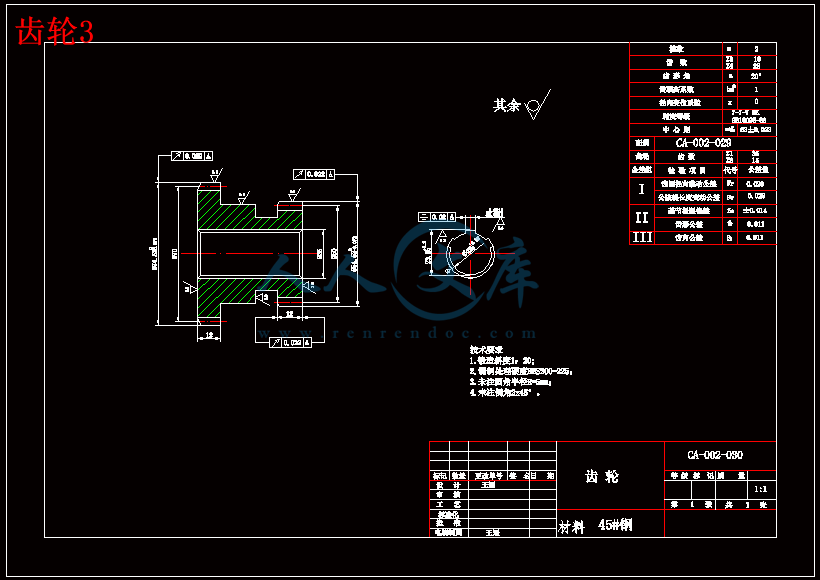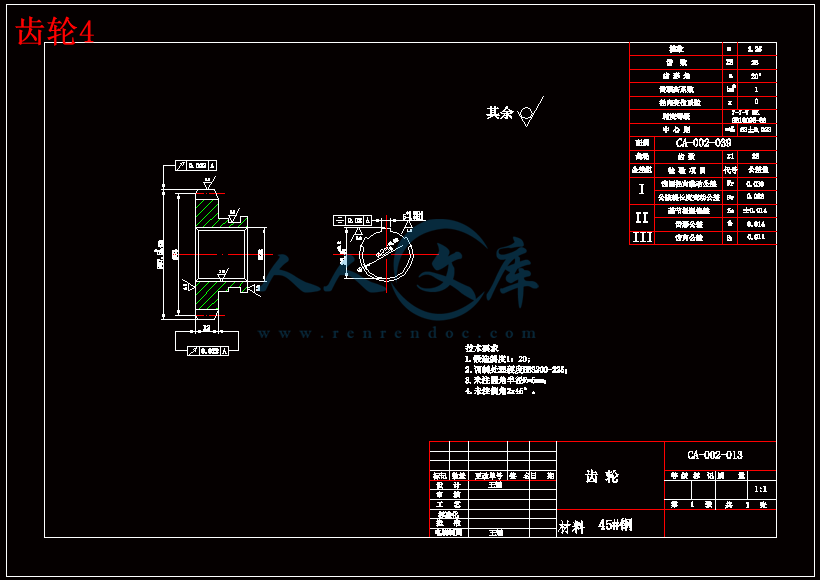【温馨提示】 购买原稿文件请充值后自助下载。
以下预览截图到的都有源文件,图纸是CAD,文档是WORD,下载后即可获得。
预览截图请勿抄袭,原稿文件完整清晰,无水印,可编辑。
有疑问可以咨询QQ:414951605或1304139763
摘要
CA6140型卧式车床是普通精度级的万能机床,它的特有功能是车削一定范围内的各种螺纹,包括切削公制螺纹、英制螺纹、模数螺纹和径节螺纹的功能,要求进给传动链的变速机构能严格准确地按照标准螺距数列来变化。CA6140型卧式车床进给箱固定在床身左前面,内有进给运动的变换装置及操纵机构,其功能是改变被加工螺纹的螺距或机动进给的进给量。变换装置包括移换机构,用来实现倒数关系及特殊因子;基本螺距机构,用来实现车削出导程值按等差数列排列的螺纹;倍增机构,用来实现车削螺纹的导程值成倍数关系变化的螺纹。
当U倍 �=1时发现一条新的传动链,可以提高部分公制及模数螺纹的切削精度,并使传动路线大大缩短。
关键词:进给箱;变换装置;移换机构;基本螺距机构;倍增机构
目录
第一章 绪论-----------------------------------------------------------------1
第二章 CA6140进给箱传动方案设计----------------------------------4
2.1 CA6140普通车床简介-------------------------------------------------------------------------4
2.2 进给箱的传动机构-----------------------------------------------------------------------------5
2.3 进给箱切螺纹机构设计----------------------------------------------------------------------8
2.4 切螺纹系统及齿数比的确定---------------------------------------------------------------9
2.5 增倍机构设计以及移换机构设计--------------------------------------------------------10
2.6 车制螺纹的工作过程-------------------------------------------------------------------------12
第三章 主要零件设计-----------------------------------------------------21
3.1 齿式离合器的设计-----------------------------------------------------------------------------21
3.2 各轴及轴上组件的设计验算---------------------------------------------------------------21
3.2.1 中心距a的确定----------------------------------------------------------------------------22
3.2.2 XII轴上齿轮的设计验算-----------------------------------------------------------------22
3.2.3 XIV轴上齿轮的验算----------------------------------------------------------------------25
3.2.4 XIV轴的设计验算-------------------------------------------------------------------------30
3.2.5 XV轴上齿轮的设计验算-----------------------------------------------------------------35
3.2.6 XV轴的设计验算--------------------------------------------------------------------------38
3.2.7 XVI轴齿轮的设计验算-------------------------------------------------------------------40
第四章 双联滑移齿轮进给箱传动系统的研究-----------------------44
4.1 新传动链车公制螺纹-------------------------------------------------------------------------44
4.2 新传动链车模数螺纹-------------------------------------------------------------------------45
4.3 新传动链的特点及适用范围---------------------------------------------------------------46
结论---------------------------------------------------------------------------48
致谢---------------------------------------------------------------------------49
参考文献---------------------------------------------------------------------50
第一章 绪 论
一、毕业设计的目的及意义
毕业设计是本科生教学活动中最后的一个重要环节。通过这个教学环节要求达到下列几个目的:
1、通过毕业设计,把在本科阶段中所获得的知识在实际的设计工作中综合地加以运用。使这些知识得到巩固,加强和发展,并使理论知识和生产实践密切地结合起来。因此,毕业设计是大学学习阶段的总结性作业。
2、毕业设计是高等学校学生第一次进行的比较完整的设计过程。通过毕业设计,培养学生独立工作、发现问题和解决问题的能力;能根据设计课题查找有关的资料,了解本课题的前沿和发展方向;树立正确的设计思想,掌握设计的基本方法和步骤,为以后从事设计工作打下良好的基础。
3、使学生能够熟练地应用有关参考资料,计算图表、手册,图集,规范,并熟悉有关国家标准和部颁标准(如GB,JB等),以完成一个工程技术人员在机械工程设计方面所必须具备的基本训练。
二、毕业设计的内容
⑴ 方案论证;
⑵ 总体分析、设计、计算;
⑶ 传动设计;
⑷ 进给箱及部分组件、零件设计
⑸ 相关资料检索、翻译。
三、完成后应交的作业(包括各种说明书、图纸等)
1.毕业设计全部资料光盘。
2.毕业设计说明书。(正文不少于1.5万字)
3.总体装配图、进给箱装配图及部分组件、零件图。(合计不少于3张A0图量)
4.相关内容检索资料与翻译(原文不少于15000字符)









 川公网安备: 51019002004831号
川公网安备: 51019002004831号